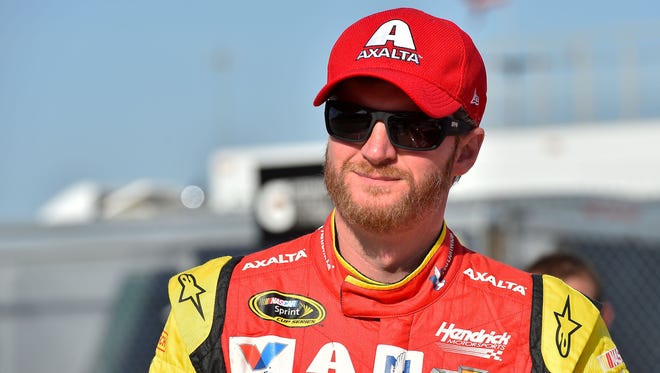Experts stress caution with Dale Earnhardt Jr.'s future

DARLINGTON, S.C. – Dale Earnhardt Jr.’s continuing problem with vision as he recovers from a brain injury is not uncommon, according to a doctor familiar with sports-related concussions.
Hendrick Motorsports announced Friday that Earnhardt will sit out the rest of the Sprint Cup season because he has not recovered from issues stemming from a concussion suffered in June. Earnhardt has said he has had continuing problems with vision and balance but that he plans to race again when his brain health is restored.
“A lot of the brain’s energy is devoted to vision,” said Vernon Williams of the Kerlan-Jobe Orthopaedic Clinic in Los Angeles. “There are tons of neurons and connections in the brain that have to do with vision, including how we are able to align the eyes and the eyes’ ability to track objects as they move across the visual field.
“Obviously, this can be a significant issue with a race car driver like him. And it’s not an uncommon symptom of concussions. It’s one that would be heightened with an individual participating in a sport like racing.”
James: It's time for Dale Earnhardt Jr. to retire
Dale Earnhardt Jr. to miss remainder of NASCAR season
Concussions often alter focus, said neurosurgeon Jim Lowe of Philadelphia.
“You don’t feel as sharp as you used to feel,” said Lowe, a former sports car driver. “The average high school football player might not notice this, but you take a NASCAR driver who has to be on the razor’s edge of concentration and reflex and give him that scenario, he’s disabled, hopefully temporarily. You have to take into consideration the population you’re dealing with.”
Neither Williams nor Lowe have treated Earnhardt.
Although Williams stressed that he is not familiar with the details of Earnhardt's situation, he said avoiding strenuous activity after a concussion is a key to recovery. And the 13-time most popular driver has admitted stress hinders his recovery.
Earnhardt, 41, has a history of concussions. He hasn’t raced this season since July 9. His latest problems apparently stem from a crash at Michigan International Speedway (although he raced three times after that crash as he tried to put his finger on what might be wrong).
Dario Franchitti texting Dale Earnhardt Jr., says 'must be a tough position'
Drivers react to Dale Earnhardt Jr. news with wait-and-see approach
“We know that once a concussion has occurred that there’s an increased risk of subsequent concussion,” he said. “The brain can be more susceptible going forward. In terms of what that means for the long-term future, that’s more slippery and difficult to predict.
“Concussions are very individual. They can be extremely variable from person to person. Two different people can have significant differences in how severe the symptoms are. Even within an individual, there may be significant variability from one concussion to another.”
Lowe said Earnhardt and his medical team likely are erring on the side of caution in extending his downtime.
“It shows an abundance of caution and, frankly, a little fear,” he said. “Nobody quite knows what the rules with concussions are right now. But guys are taking this very seriously, thankfully, if they’ve had multiple concussions. Problems from a concussion can be amplified if the recovery from a previous concussion isn’t complete. Everybody is scared of stacking one on top of the other.”
Key moments in Dale Earnhardt Jr.'s career
Dale Earnhardt Jr.'s NASCAR career by the numbers
It's those subsequent concussions - or softer hits - that are worrisome. The long-term damage and effects from accumulated hits can lead to nasty issues, not the least of which is chronic traumatic encephalopathy - a degenerative brain disease associated with repeated head trauma. Earnhardt is familiar with this issue and in March, pledged his brain to science for the further study of conditions like CTE.
Williams said returning to strenuous activity too soon after a concussion also can have negative consequences.
“Normally, you’re most worried about healing being delayed by activity early on in the course of a concussion,” he said. “The brain needs a lot of energy to try to heal and recover a kind of normalcy.”
Williams said Earnhardt’s continued absence from the race car “means it’s probably more likely that there may be concern that he may not be able to perform in the ways he needs to to avoid risk of another injury. Some concussions show a persistent deficit regarding vision or reaction times or speed of mental processing during exertion.
“Dale has made some comments that his testing continues to improve. The brain is going to heal at its own rate. It’s probably more likely that he’s sitting out to avoid other injury than something that’s needed in order to gain improvement.”
Follow Hembree on Twitter @mikehembree
